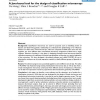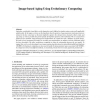3333 search results - page 550 / 667 » New Invariants for Groups |
BIOINFORMATICS
2010
13 years 10 months ago
2010
Phylogenetic trees are widely used to display estimates of how groups of species evolved. Each phylogenetic tree can be seen as a collection of clusters, subgroups of the species ...
BMCBI
2008
13 years 10 months ago
2008
Background: Classification microarrays are used for purposes such as identifying strains of bacteria and determining genetic relationships to understand the epidemiology of an inf...
CGF
2008
13 years 10 months ago
2008
Aging has considerable visual effects on the human face and is difficult to simulate using a universally-applicable global model. In this paper, we focus on the hypothesis that th...
CORR
2010
Springer
13 years 10 months ago
2010
Springer
-- In cluster-based routing protocol (CBRP), two-level hierarchical structure is successfully used to reduce over-flooding in wireless ad hoc networks. As it is vulnerable to a sin...
CORR
2008
Springer
13 years 10 months ago
2008
Springer
The methods used to establish PSPACE-bounds for modal logics can roughly be grouped into two classes: syntax driven methods establish that exhaustive proof search can be performed...


